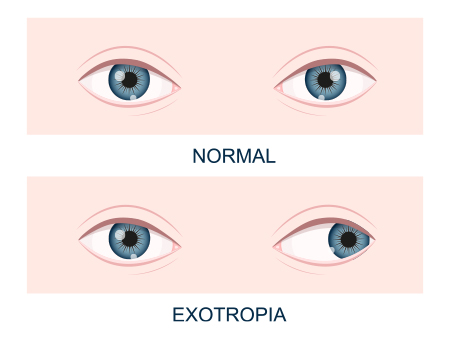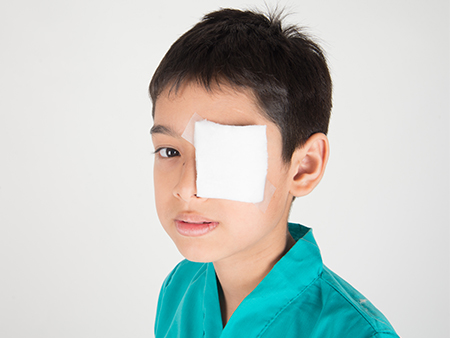Exotropia is a kind of strabismus in which one or both eyes turn outward. Strabismus is the misalignment of the eyes.
It is the inverse of esotropia, also known as crossed eyes. Exotropia can be intermittent, occurring from time to time, or constant. It can be noticed in people of all ages.
Overview
Exotropia is the common type of strabismus seen around the world.
It is defined as an outward deviation of one or both eyes. These can be either concomitant or incomitant.
Concomitant deviation is when the divergent deviation of the visual axis remains constant across all positions of gaze. Incomitant deviation denotes that the divergent deviation of the visual axis varies across gazes.
Types of Exotropia
Congenital exotropia
Congenital exotropia is also referred to as infantile exotropia. People with this condition tend to roll their eyes externally from birth or childhood.
This is a large angle, usually constant exodeviation that appears during the first six months of life and does not resolve.
Cerebral palsy and other neurologic or craniofacial disorders are more likely to cause congenital exotropia. A careful developmental history is essential in these patients, and consultation with a neurologist should be considered.
Sensory exotropia
Sensory exotropia is an outward deviation caused by poor vision in the eye. An eye that has poor eyesight or is blind may drift outward.
Infants and young children with such vision tend to develop esotropia, whereas children older than 2-4 years and adults typically develop exotropia.
Acquired exotropia
Exotropia that develops due to another health condition, especially those targeting the brain, is termed acquired exotropia.
These conditions include stroke, down syndrome, trauma, thyroid disorder, cerebral palsy and brain tumour.
Medical conditions like glaucoma and cataract can also increase the likelihood of developing acquired exotropia.
Intermittent exotropia
The most common type of exotropia is intermittent exotropia. It is estimated that 1% of the population suffers from intermittent exotropia.
Eye turning occurs only occasionally due to illness, fatigue, concentrating on distant objects or staring for a long time.
Intermittent exotropia is mostly infrequent, but they can occur frequently enough to become a permanent problem. Intermittent exotropia causes children to become nearsighted during childhood or adolescence.
Consecutive exotropia

Consecutive exotropia can occur after surgery done to correct misaligned eyes. This is thought to result from damage to the muscles that control eye movement during the procedure.
Causes of Exotropia
There is no single cause of exotropia. The following are some eye diseases that may increase the risk of developing exotropia:
Duane’s syndrome
Duane’s syndrome is a congenital strabismus syndrome. People with this condition mostly have
- Amblyopia – lazy eye
- Anisometropia (different refractive errors in the two eyes)
- Diplopia – double vision
Slipped or lost medial rectus muscle
Medial rectus muscle can be lost following various types of eye surgery.
Examples of eye surgeries that cause this include
- Retinal detachment surgery and
- Paranasal sinus surgery
Internuclear ophthalmoplegia
Internuclear ophthalmoplegia is a problem with ocular motility, which is eye muscle paralysis or weakness. This disorder impairs lateral vision and results in ophthalmoplegia.
Orbital fibrosis
Orbital fibrosis is an uncommon condition distinguished by an infiltrating orbital mass and connective tissue thickening.
Cataract
Strabismus is a common complication in children following cataract surgery. Unilateral cases and young age surgery are risk factors. Children with poor final visual acuity are more likely to have exotropia.
Stroke
Eye movement and position issues are noticeable after a stroke. These defects are caused by damage to areas of the brain and nerves that control eye movements.
Risk factors of exotropia
Family history
Exotropia risk is increased when there is a family history of amblyopia, strabismus, childhood cataract or glaucoma (increased eye pressure).
Some genetic disorders
Genetic disorders that affect the eye, like Down syndrome or cerebral palsy, increase the risk of exotropia.
Pediatric cataracts or glaucoma
Childhood cataracts or glaucoma are known to cause exotropia.
Symptoms of Exotropia
Exotropia symptoms can be aggravated by prolonged desk work, reading and computer use.
Outward eye turn
Since the eye with reduced vision is unable to collaborate with the other eye, the worse seeing-eye may tend to drift outward.
Frequent rubbing of the eyes
Rubbing the eyes frequently and covering one eye happens when looking into bright light or trying to see distant objects.
Squinting
Strabismus, also known as squinting, occurs due to the failure of the two eyes to maintain proper alignment.
Diagnosis of exotropia
Vision Test
A vision test helps diagnose exotropia. A health care practitioner or doctor examines the eye using a slit lamp microscope.
The microscope directs a bright, narrow beam of light into the eye. The slit lamp provides a magnified, three-dimensional view of the eye, allowing the doctor to detect any minor abnormalities.
Ocular alignment test
The Hirschberg test also referred to as the corneal light reflex test, is a quick and easy method for determining ocular alignment.
According to an article titled ‘How to check eye alignment and movement’, eye alignment can be examined through the Hirschberg test.
This is done by comparing the light reflexes of the eye corneas. A torch is placed 1 metre in front of the eyes and looked for light reflex on the cornea.
The light reflexes on each cornea should be symmetrical in the primary gaze, looking straight ahead at the torch light. Exotropia is confirmed when one eye turns outward.
Cycloplegic refraction test
Cycloplegic refraction is a procedure in which the eye doctor uses eye drops to relax the focusing muscles.
This dilates the pupils, preventing the individual from over-focusing during the eye exam. As the eye doctor will have a better view of the inside of the eyes, signs of eye disease will be easier to detect.
Treatment for Exotropia
Glasses
Intermittent exotropia is frequently treated with glasses fitted with special lenses known as over minus glasses.
These glasses are similar to those prescribed for nearsighted individuals. To see clearly, these glasses make the eyes work harder.
The additional work is thought to help the eye drift out less frequently.
Prisms in the lenses of special glasses can help reverse exotropia’s outward eye movement and reduce eye strain.
Patching

Patching the dominant eye or alternate patching of either eye is used to stop or slow the progression of exotropia.
Part-time patching for 2-4 hours per day is known to help the brain stop using abnormal neurological pathways while encouraging the normal neurological pathway.
This technique is not usually effective for many. Patching effectively improves deviation control in children aged 3 to 8 who have intermittent exotropia.
Exercises
A lot of vision therapy programmes now include eye exercises. These can aid in the improvement of coordination. The three common exercises suggested to treat exotropia are
- Pencil pushups
- Barrel cards
- Brock string
Eye muscle surgery
Eye muscle surgery is used to loosen or tighten the eye muscles in one or both eyes to improve eye alignment. When there is extreme eye drifting, this surgery is usually a better option.
Preventions of exotropia
Routine eye checkups
To prevent exotropia, routine eye checkups must be done to detect latent squints and refractive errors and apply corrective measures.
Avoiding stressful conditions
Exotropia usually happens during stressful situations. Avoiding it can help prevent the condition.
When to see a doctor?
Exotropia is common and treatable if detected and corrected at a young age. The eyes should be aligned and able to focus by four months of age. A doctor should be consulted if any misalignment occurs after four months of birth.
Conclusion
Exotropia is the outward deviation of one or both eyes. There is no defined cause of exotropia, but certain eye diseases can increase the risk of the disease. It is treatable when noticed and corrected at a young age. Overmind glasses, eye patching and eye exercises can treat exotropia. In extreme eye deviation, surgery may be required.
FAQs
How is exotropia diagnosed?
The following tests help to diagnose exotropia.
1· Vision Test
2· Motor sensory exam – Ocular alignment test, Extraocular muscle movement evaluation
3· Cycloplegic refraction tests
4· Slit-lamp exam
Can exotropia be cured?
Exotropia can be treated when diagnosed at an early age. But most types of exotropia cannot be resolved entirely.
What happens if exotropia is left untreated?
If exotropia is left untreated, the eye may constantly turn out and lose stereopsis or binocular vision.
How do you test for exotropia?
Specialised tests like comprehensive eye and vision evaluation can determine the presence of exotropia.
Outward eye movement can be observed in a cover test where one eye is covered.
DISCLAIMER: THIS BLOG/WEBSITE DOES NOT PROVIDE MEDICAL ADVICE
The Information including but not limited to text, graphics, images and other material contained on this blog are intended for education and awareness only. No material on this blog is intended to be a substitute for professional medical help including diagnosis or treatment. It is always advisable to consult medical professional before relying on the content. Neither the Author nor Star Health and Allied Insurance Co. Ltd accepts any responsibility for any potential risk to any visitor/reader.





